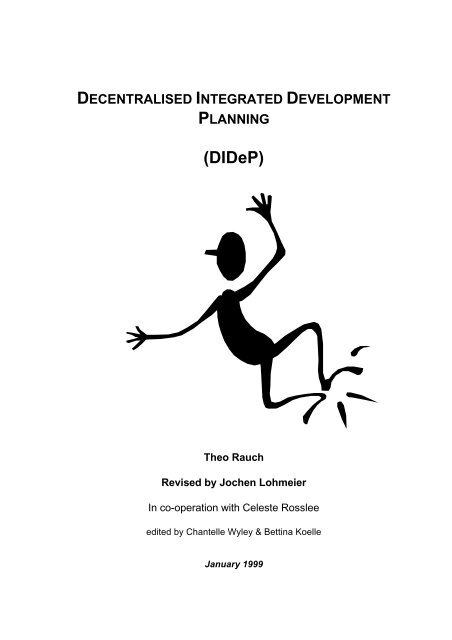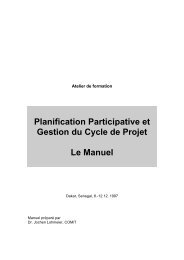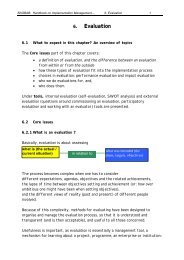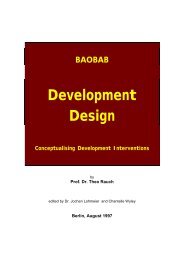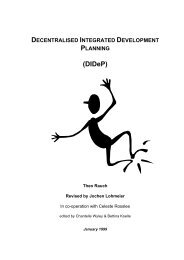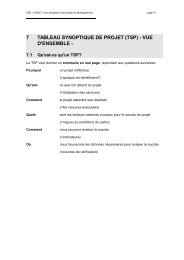Introduction - Baobab
Introduction - Baobab
Introduction - Baobab
Create successful ePaper yourself
Turn your PDF publications into a flip-book with our unique Google optimized e-Paper software.
DECENTRALISED INTEGRATED DEVELOPMENT<br />
PLANNING<br />
(DIDeP)<br />
Theo Rauch<br />
Revised by Jochen Lohmeier<br />
In co-operation with Celeste Rosslee<br />
edited by Chantelle Wyley & Bettina Koelle<br />
January 1999
i DIDeP <strong>Introduction</strong><br />
<strong>Introduction</strong><br />
Decentralised Integrated Development Planning (DIDeP) has a tradition of some 30<br />
years, but it never quite made it to get acknowledged as a discipline. This should<br />
change now.<br />
DIDeP has three founding pillars: decentralisation, integration, development.<br />
As early as after de-colonisation in the 1960ties, decentralisation was on the agenda.<br />
It was linked to nation-building. In order to mobilise the nation-wide internal resources<br />
of a state, national governments needed to develop an area-covering footing and<br />
spread presence across the whole country. Complementarily, at the beginning of<br />
globalisation, international institutions provided a hand in the same direction.<br />
As early as in 1969, after frustrations with mono-sectoral modernisation attempts, the<br />
World Bank charged a group of specialists with different backgrounds to draw up a<br />
multi-sectoral development plan for the far-western province of Kigoma in Tanzania,<br />
on the border to Ruanda and Burundi. Tanzania – and many other countries followed<br />
suit – embarked on this approach for all it’s provinces, which were foster-fathered by<br />
various donor-countries. But: the attempts at integration of these comprehensive<br />
sector plans took some 2-3 years to be drafted. What was required was a more<br />
focussed, problem-prioritising approach.<br />
Although with some delay, projects and programmes were implemented, mostly<br />
funded by donors with substantial budgets, often against the odds of sectoral<br />
responsibilities of functional departments. One major lesson learnt relates to<br />
decentralised development, be it services or economic / ecological measures: it<br />
became rather donor dependant than influencing and resourced by national or local<br />
budgets; but donors provided just temporary interventions whereas development is of<br />
permanent character. This misfit lead to the conclusion that development is a change<br />
process which to the largest extent happens on individual and business level, that any<br />
intervention should only be of help (= subsidiary). In order to design development<br />
interventions, the experience gained with the multisectoral-integrated, decentralised<br />
development plans constitute an invaluable resource. We have drawn on this.<br />
What can you expect from this book?<br />
This publication is based on continuous research since the 1970ties and more than<br />
quarter of a century own experience of the authors in international development work.<br />
It was successively put together while teaching post-graduate university students and<br />
groups of experienced international development practioners over the last 10 years on<br />
regional planning, on rural development, on designing programmes and projects. This<br />
is one of the reasons, why the material provided does not yet lend itself completely to<br />
self-studying.<br />
This handbook has been developed with public funds and is therefore a public domain<br />
software.
DIDeP <strong>Introduction</strong> ii<br />
As often with course material, there are changes every now and then, depending on<br />
the audience, or on new insights. The material is available on the Internet, too.<br />
Updating is easier, hence.<br />
What made this publication and respective training courses attractive are the following<br />
issues:<br />
- It is neither an academic approach nor is it specifically made for application only in<br />
one context, but it is experience driven, and systematically links theory background<br />
with respective strategies with respective tools.<br />
- It provides a system for development planning / interventions which allows to bring<br />
a helpful order into the complex reality of development, which again stimulates to<br />
transparently structure and sequence approaches in every case.<br />
- It can be learnt by everybody with basic academic qualifications, although it<br />
requires a high standard of analytical capacities and dedication to make concepts<br />
as well as tools fit to the own approaches.<br />
- It has proven to be highly useful and effective for those who applied the approach<br />
in their development work, even if it was just the most appropriate bits and pieces<br />
from the whole basket selected according to own needs.<br />
We have structured the publication in the following way:<br />
We provide a general introduction to development and the experiences gained with<br />
intervention measures, and we provide a general methodological approach to dealing<br />
with developmental issues (Module A).<br />
We then walk you through 5 different aspects of designing development interventions:<br />
• Participatory approaches (Module B),<br />
• Economic viability (Module C),<br />
• Ecological sustainability (Module D),<br />
• Target group and gender orientation (Module E),<br />
• The institutional and political dimensions of development interventions, which are<br />
presently known under the fashionable term of ‘capacity building’ (Module F).<br />
In each of these aspects<br />
we try to provide some doctrines or theoretical background,<br />
we present and discuss strategic options,<br />
we offer tools for analysing specific situations, and<br />
we suggest remedies or intervention measures.<br />
This structure can also be presented as a table:
iii DIDeP <strong>Introduction</strong><br />
Doctrines<br />
Strategies<br />
Tools<br />
Remedies<br />
Participatory<br />
Approaches<br />
Economic<br />
Viability<br />
Ecological<br />
Sustainability<br />
Target<br />
Group and<br />
Gender<br />
Orientation<br />
Institutional<br />
and political<br />
Dimension<br />
The last chapter tries to package the preceding deliberations into consistent<br />
implementable measures, which often are called projects or programmes. Those need<br />
to be planned and their implementation to be monitored and evaluated (Module G).<br />
This is where this publication ends. The hardware of project cycle management as<br />
well as the behavioural software of communication and facilitation are different<br />
publications (and separate training courses).<br />
In more detail the following table gives an overview of the structuring of contents:
DIDeP <strong>Introduction</strong> iv<br />
Dimension<br />
General<br />
approach<br />
Contents<br />
Theory Development<br />
Theories:<br />
Modernisation<br />
Dependency<br />
Globalisation<br />
Strategy RD objectives &<br />
principles<br />
Metamethodology<br />
Analytical<br />
tools<br />
Problem Analysis<br />
Potential analysis<br />
Alternative<br />
Analysis<br />
Measures Participative<br />
planning<br />
Participation Economy Ecology Social/<br />
Cultural<br />
Participation in<br />
practice –<br />
theoretical<br />
orientation<br />
Optimising<br />
Participation<br />
Participation<br />
design<br />
Regional economic<br />
development<br />
theories<br />
Functional –<br />
territorial approach<br />
Employment<br />
creation<br />
PRA Feasibility:<br />
- productivity<br />
- profitability<br />
- cost-benefit<br />
analysis<br />
Viable<br />
participation<br />
design options<br />
Diversification<br />
Subsidies<br />
Ecological aims in<br />
relations to IRDP<br />
Sustainable use<br />
of resources<br />
Land use<br />
Planning<br />
Environmental<br />
Impact<br />
Assessment<br />
Resource<br />
management<br />
Multiple<br />
Realities<br />
Participation<br />
Gender – and<br />
target group<br />
orientation<br />
Target group<br />
analysis<br />
Participants<br />
analysis<br />
Social impact<br />
analysis<br />
Target group<br />
adjustments<br />
Self targetting<br />
Political/<br />
Institutions<br />
Theoretical<br />
understanding of<br />
organisations and<br />
their development<br />
Promotion of<br />
institutions and<br />
organisations -<br />
capacity building<br />
Institutional and<br />
organisational<br />
analysis<br />
Training<br />
Re-organising<br />
Establishing<br />
Co-ordination<br />
Roles of projects<br />
Problem solving strategies<br />
and methods<br />
Logical Framework<br />
Planning<br />
Plan of operations<br />
M & E
v DIDeP <strong>Introduction</strong><br />
As mentioned above, this publication is used as a Manual for a respective training<br />
course. The course takes between 2 – 3 weeks net, and can be staggered for phases<br />
of application in-between.<br />
Objectives of the seminar on methods and techniques of<br />
Decentralised Integrated Development Planning<br />
GOAL Delegating agencies are able to apply<br />
relevant aspects of regional rural<br />
development in design and planning in<br />
order to achieve their objectives<br />
PURPOSE Participants cope better with the<br />
challenge to contribute to broad-based<br />
and sustainable development under<br />
difficult frame conditions
DIDeP <strong>Introduction</strong> vi<br />
OUTPUTS Participants<br />
Our approach<br />
are familiar with the background,<br />
objectives and principles of<br />
decentralised integrated<br />
development theory and practice<br />
are aware of difficulties in<br />
implementing development<br />
explore possible strategic options<br />
in coping with prevailing economic<br />
frame conditions<br />
are aware of strategic options for<br />
ensuring ecological sustainibility<br />
know how to apply a target group<br />
and gender specific approach in<br />
development practice<br />
widen their knowledge of adjusted<br />
methods of people’s participation<br />
are aware of ways to promote<br />
self-help organisations<br />
explore possible strategic options<br />
in coping with prevailing<br />
institutional frame conditions<br />
are aware of different functions of<br />
projects and conditions of donor<br />
support<br />
⇒ Interlinks the economic, ecological, social and institutional-organisational<br />
dimensions of regional development design and planning<br />
⇒ Interlocks development policy issues with practical methods of design and<br />
planning<br />
⇒ Matches “theoretical” background from faculty / professionals with “practical”<br />
experience of participants<br />
What we offer in this course
vii DIDeP <strong>Introduction</strong><br />
• Familiarity with the principles and objectives of the decentralised integrated<br />
development design and planning<br />
• Awareness of typical difficulties in implementing development measures<br />
• Knowledge of relevant strategies to cope with prevailing (difficult) frame conditions<br />
• An overview of relevant development design and planning methods, and ways to<br />
assess their potentials and limitations<br />
Learning modes<br />
The seminar uses various faculty-participant combinations to provide learning space<br />
and opportunities:<br />
Reading tasks<br />
Inputs from faculty<br />
Role plays<br />
Task groups (to work on a case study which provides some 6000 data to<br />
simulate a sand box for exercising)<br />
Plenary workshops<br />
Learning groups<br />
Total learning community<br />
Feedback committee / Evaluation<br />
Case consultation<br />
Individual application
DIDeP <strong>Introduction</strong> viii<br />
Table of Contents<br />
Module A Development Approaches to Regional Planning<br />
Topic 1 <strong>Introduction</strong> into regional planning theories and strategies<br />
1.1 <strong>Introduction</strong><br />
1.2 Historical overview of strategies of integrated development<br />
Topic 2 Regional Planning Objectives and orientations<br />
2.1 DIDEP objectives and principles: a system<br />
2.2 Rural poverty: a problem scenario<br />
2.3 Hierarchy of objectives for regional development interventions<br />
2.4 Design and implementation difficulties: lessons from international experience<br />
2.5 Deficiencies of development inventions: a brief overview<br />
2.6 Poverty orientation<br />
2.7 Sustainability<br />
2.8 Multisectoral and regional approach<br />
2.9 South African Context<br />
Topic 3 Meta-Methodology: the basis of this approach to development analysis and strategy<br />
design (planning)<br />
3.1 Regional planning in the process of development: definition and roles<br />
3.2 Problem focused planning with a systems perspective<br />
3.3 Interlinking bottom-up and top-down planning<br />
3.4 Planning procedure: an overview<br />
Topic 4: Regional Situation Analysis<br />
4.1 <strong>Introduction</strong><br />
4.2 Expected results of situation analysis<br />
4.3 Methodology of situation analysis<br />
4.4 Steps within regional situation analysis<br />
Topic 5: Some Practical Tools Used in a Contextual Regional Situation Analysis<br />
5.1 Problem Analysis<br />
5.2 Potentiality Analysis<br />
Topic 6: Planning options following situation analysis<br />
6.1 <strong>Introduction</strong><br />
6.2 Procedure<br />
6.3 Alternative Analysis
ix IDeP <strong>Introduction</strong><br />
Module B Participation<br />
Topic 1 Definition, background, principles and problems experienced with participation<br />
1.1 Definition<br />
1.2 Reasoning - why participation<br />
1.3 Some non-participatory practices claiming to be participatory (but are not)<br />
1.4 Problems in implementing participation<br />
Topic 2 Strategic elements in participation<br />
2.1. Principles for the participation of the mass of target groups in regional development<br />
interventions<br />
2.2 Participation as informed decision-making in attuned ways: the rationale<br />
2.3 Different means of enhancing participation<br />
Topic 3 Participatory rapid appraisal techniques<br />
3.1 What is PRA?<br />
3.2 Why use PRA?<br />
3.3 What are the key ideas underlying PRA?<br />
3.4 Where has PRA mainly been used?<br />
3.5 Wen is PRA used?<br />
3.6 Limitations of PRA<br />
3.7 The PRA tool box<br />
3.8 How to conduct PRA?<br />
Topic 4 How to design viable participation processes?<br />
4.1 Appropriate combination of methods of participation<br />
4.2 Overview over relevant methods of participation in different planning steps<br />
Topic 5 Example: A decentralised participatory planning process<br />
5.1 Summative diagram of steps<br />
5.2 Steps in designing and institutionalising a decentralised participatory planning<br />
process
IDeP <strong>Introduction</strong> x<br />
Module C Economic Dimension<br />
Topic 1 Regional economic development theories and concepts<br />
1.1 <strong>Introduction</strong>:<br />
1.2 Overview of regional development theories, respective planning approaches, their targets<br />
and types of intervening<br />
1.3 Regional development theories and strategies in detail<br />
Topic 2 Economic strategies to consider during regional planning<br />
2.1 Functional and territorial approach<br />
2.2 Promotion of viable locally interlinked economic activities<br />
2.3 Employment creation through consideration of interrelations between technology level,<br />
income distribution and production patters.<br />
2.4 Economies and diseconomies of scale<br />
2.5 Difficulties encountered by development interventions with respect to economic frame<br />
conditions<br />
Topic 3 Economic Analysis<br />
3.1 Economic feasibility figures<br />
3.2 Planning methodology: economic appraisal<br />
Topic 4 Economic Measures and Interventions<br />
4.1 Diversification<br />
4.2 Subsidies<br />
Annex:<br />
Module C Basic concepts of macro-economic models and statistics
xi DIDeP <strong>Introduction</strong><br />
Module D Ecological Dimension: Natural Resources in Marginal Environmental Conditions<br />
Topic 1 Ecological Issues to Consider in Integrated Regional Development<br />
1.1 Ecological aims in relation to other DIDeP objectives<br />
1.2 Problems experienced and typical reactions of interventions<br />
1.3 Strategy elements<br />
Topic 2 Land Use Planning<br />
2.1 Definition<br />
2.2 Context<br />
2.3 Cases for Land Use Planning<br />
2.4 Levels of LUP<br />
2.5 Implementation instruments of land use plans<br />
2.6 Planning methodology<br />
Topic 3 Design and Planning Methodology: Ecological Analysis and<br />
Appraisal<br />
3.1 Environmental Impact Assessment (EIA)<br />
Topic 4 Ecological Measures<br />
4.1 Resource management<br />
Module E Target Group and Gender Orientation<br />
Topic 1: Theoretical Background<br />
1.1 The concept of multiple realities<br />
1.2 Poor people’s own strategies for their poverty-reduction<br />
1.3 Definitions<br />
Topic 2: Strategic Principles in Target Group and Gender Orientation<br />
2.1 Principles of target group orientation<br />
2.2 Principles of gender orientation<br />
2.3 Overview of steps in target group and gender oriented planning<br />
Topic 3: Target Group and Gender Analysis<br />
3.1 Target groups analysis<br />
3.2 Gender Analysis
DIDeP <strong>Introduction</strong> xii<br />
Topic 4: Adjustment of Measures to Specific Target Groups<br />
4.1 Identification of target groups for regional planning<br />
4.2 Self-targeting design<br />
4.3 Alternatives in adjusting measures to target groups<br />
Module F Institutional-Political Dimension<br />
Topic 1: Theoretical elements which help to understand institutional and organisational<br />
development<br />
1.1 Cornerstones of general development and institutional development<br />
1.2 Different types of how people organise in a society<br />
1.3 Roles of the state and roles of civic society<br />
1.4 Purposes and types of Self-Help-Organisations<br />
1.5 The internal functioning of organisations<br />
Topic 2: Strategic elements for institutional and organisational development<br />
2.1 Promotion of institutions and organisations<br />
2.2 State-related institutional frameconditions and promotion strategies<br />
2.3 Promotion of Self-Help-Organisations<br />
Topic 3: Organisational analysis<br />
3.1 Context of organisational analyses<br />
3.2 Methodological orientations<br />
3.3 Steps in an organisational analysis<br />
3.4 Identification of service structures and change agents<br />
Topic 4: Measures for institutional development and organisational development<br />
4.1 Development of service agencies<br />
4.2 Measures for the development of Self-Help-Organisations
xiii DIDeP <strong>Introduction</strong><br />
Module G Co-ordinated Implementation<br />
Topic 1: The Roles of Projects and External Support Agencies<br />
1.1 Summary of problem-solving strategies and methods<br />
1.2 Definition of the role of a project<br />
1.3 Strategic objectives of development-projects (generalised)<br />
1.4 Roles of external support agencies<br />
1.5 Role of projects and external support agencies in development programmes<br />
1.6 Interlinkages among Project/Programme Management Function<br />
Topic 2: Logical Framework Planning (of interventions, projects, programmes)<br />
2.1 Overview<br />
2.2 Formulating an intervention strategy<br />
2.3 Assumptions and Risks<br />
2.4 Indicators<br />
2.5 Means of Verification (MoV) - (in brief)<br />
Topic 3: Coordination by Action Planning<br />
3.1 The PlanOp (Plan of Operations)<br />
3.2 Combined workplan and project budget (example)<br />
3.3 How to construct a combined workplan and project budget<br />
3.4 Recommended structure of a Plan of Operation (PlanOp)<br />
Topic 4: Decision-making during implementation based on Monitoring<br />
4.1 Monitoring and review<br />
4.2 External Evaluation<br />
4.3 Procedures for carrying out an evaluation<br />
<strong>Introduction</strong>.doc * 16/02/99


